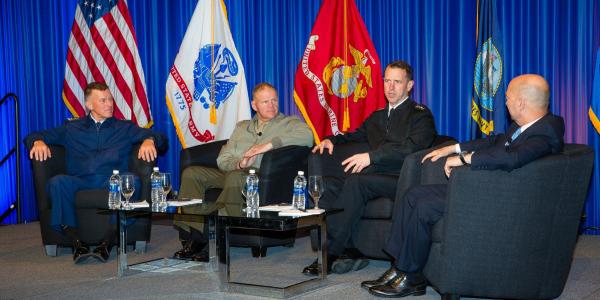A Sea Change Moment for the Sea Services
Money might buy badly needed fleet upgrades, but it won’t buy fixes for problems that have been building in the sea services over the past decade. Reforming technology acquisition, speeding up innovation and reclaiming combat supremacy will require shifting away from traditional approaches, said the chiefs of the U.S. Navy, Marine Corps and Coast Guard and other experts at the West 2018 conference, co-sponsored by AFCEA International and the U.S. Naval Institute.
One possible starting point is the defense budget. Short-term budget resolutions can make long-term planning difficult. Marine Corps Commandant Gen. Robert B. Neller, USMC, said of Congress: “If they can do a multiyear budget without having to deal with the Budget Control Act, that will help us because we can plan. The adversary out there is making big investments.”
The Navy must do the same to enhance and expand its fleet. Last year’s National Defense Authorization Act calls for an increase from about 274 ships to 355 ships as quickly as possible. But the shipbuilding industrial base has shrunk greatly—by one-third since 1955, explained Chief of Naval Operations Adm. John M. Richardson, USN. The Navy is pursuing alternative production methods as it seeks to replace Trident ballistic missile submarines (SSBNs).
“We have a family of plans, some status quo,” he said. “Every trick in the book is on the table.”
The Coast Guard has a dire need for new icebreakers as ships age and climate changes. Adm. Paul F. Zukunft, USCG, commandant of the Coast Guard, also warned that the U.S. sealift fleet is so old that few mariners know how to operate the steamships.
This reality stands in stark contrast to near-peer rivals such as Russia, which asserts itself as a maritime power. “As Russia continues to fund and advance in the maritime, particular their undersea capabilities, we have to keep up with them,” Adm. Richardson said.
Another near-peer competitor, China, is building a $2.1 billion research park for artificial intelligence (AI). The country laid out a development plan last year to become the world leader in AI by 2030. “Where’s our AI center?” asked Capt. Sean Heritage, USN, Navy and IT portfolio lead, in a panel discussion.
In the AI race, the United States still can win, said Ryan Tseng, CEO and co-founder of Shield AI, San Diego, at a Young AFCEAN panel on the subject. The world’s best AI talent must be enticed to solve defense and national security challenges, he recommended.
Ramping up U.S. efforts in AI will involve solving problems that inhibit innovation and rapid deployment, stated James F. Geurts, assistant secretary for the Navy for Research, Development and Acquisition, in a keynote speech. Decision making is moving lower in the organizational hierarchy to resolve issues faster. “I’m looking at decisions that I was making at my level that can be pushed down to the PEO level,” he said. “And we’re looking at moving decisions from the PEO level.
“There’s a lot we can control within our own four walls. Let’s take those things on first,” he advised.
Sensors, weapons and platforms that can talk to each other are necessities, shared Vice Adm. Jan Tighe, USN, deputy chief of naval operations for information warfare (IW) and director of naval intelligence. So are skilled information warfare professionals.
“We are not going to be able to meet the price point offered by the private sector,” Adm. Tighe said. “So, to get good people, we are trying something new: Give them the training they need, put them on an important mission, and get out of their way.”
For more from West, visit url.afcea.org/West18archive.





Comments